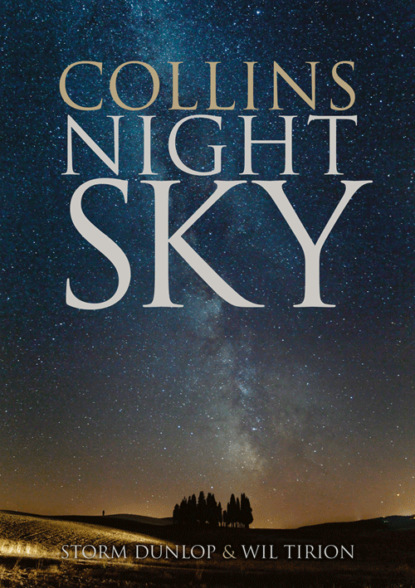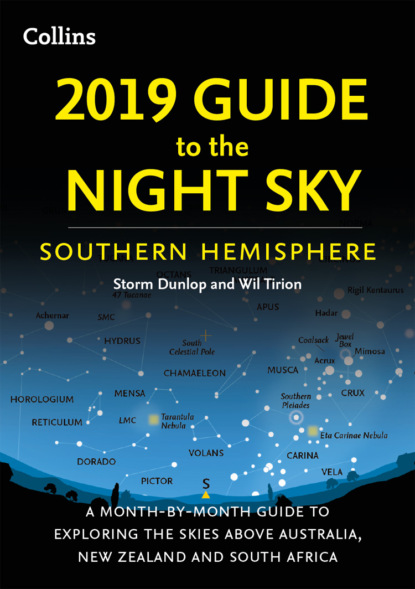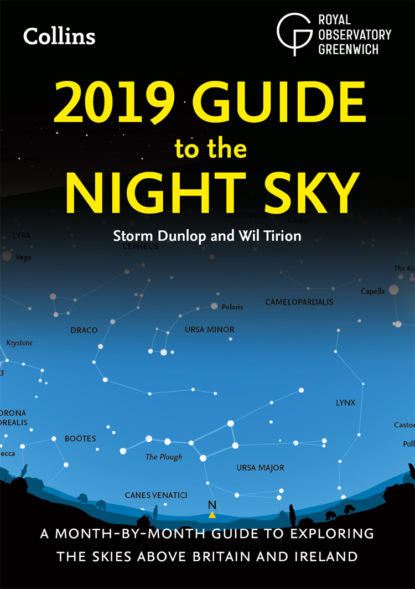
Текст
отзывы: 0 | рейтинг: 0
Полная версия
Полная версия
1
2
Collins Night Sky
Wil Tirion
Storm Dunlop
An introductory guide to navigating your way around the night sky and identifying what you can see on any given night.Designed as a comprehensive introduction for the beginner and those who want to find out more, How to Identify the Night Sky covers everything that can be seen with the naked eye and binoculars, as well as what is visible using a small telescope.There are sections on how to observe and understand the objects that comprise the night sky, the moon, the movements of the stars and planets throughout the year and astronomical events.The constellations are given a comprehensive treatment. For each one there is a chart, a photograph, a description of its features and history, the best dates and times of visibility, the mythological representation and a list of interesting objects.
COLLINS
NIGHT
SKY
STORM DUNLOP & WIL TIRION
CONTENTS
Cover
Title Page (#uaa4e3e2c-15cc-5d2d-a00f-02dd3a5b486b)
HOW TO USE THIS BOOK
OBSERVING THE NIGHT SKY
What to use (#ulink_fa95690f-f466-5359-9685-64e425902577)
Starting out (#ulink_bd62b9b1-f40e-5329-8ae4-d248549c85ce)
Exploring the night sky (#ulink_40fe29d5-13c4-5ec8-816e-e05ea3fb9d12)
The celestial sphere (#ulink_b870d150-b665-5cf8-b3c3-21a66b0383d1)
Positions in the sky (#ulink_a7e00431-4b81-5ce8-bab6-44861a70979a)
Date and time (#ulink_443ccec9-6b1f-5124-b084-cdebe6c9ff1d)
Constellations
The names of stars and other objects
Magnitudes
Photographing the night sky
THE CELESTIAL SPHERE
Winter constellations
Spring constellations
Summer constellations
Autumn constellations
MONTHLY CHARTS
THE MOON
Lunar eclipses
The surface of the moon
North-west quadrant
North-east quadrant
South-west quadrant
South-east quadrant
THE PLANETS
Planetary positions
Minor planets
OBJECTS IN THE SKY
Nacreous and noctilucent clouds
Aurorae
Rockets and satellites
Meteors and the zodiacal light
Comets
Stars
Clusters
Nebulae
Galaxies
CONSTELLATIONS
ADDITIONAL TABLES
FURTHER INFORMATION
GLOSSARY
INDEX
Copyright
About the Publisher
HOW TO USE THIS BOOK (#ulink_20cf7c11-00fb-56b8-b664-a52091aec177)
This book is intended for those taking an interest in the sky, wanting to find their way around among the many constellations, and also carry out simple observing with the naked eye, binoculars or small telescopes.
The first section begins with some general advice on OBSERVING THE NIGHT SKY. This is followed EXPLORING THE SKY (#ulink_40fe29d5-13c4-5ec8-816e-e05ea3fb9d12) by information that will help readers to locate objects in the sky, and also to understand the charts, diagrams, and tables of positions that are provided both in this book and elsewhere. This portion includes descriptions on the names of stars and other celestial objects, together with the reasons for their differences in brightness and colour. The section ends with some information about simple photography.
The next section will help beginners to find their way around the sky. This is not as complicated as it might at first appear. Everyone starts by learning to recognize the five main circumpolar constellations, which are visible whenever the sky is clear (THE CELESTIAL SPHERE (#u1f29faa1-6a3c-5825-925e-b21c7545426c)). The next few pages describe the location and recognition of the constellations that are most clearly visible at different seasons, together with the most notable objects in that part of the sky. Although arranged to start with the winter, readers may choose any season to begin observing. The same applies to the following section (MONTHLY CHARTS), which shows the appearance of the night sky with two charts for each month of the year, looking north and looking south.
Specific information about individual objects follows, beginning with the Moon (THE MOON), and then the planets, including detailed charts showing planetary positions for a period of five years. These are followed by charts showing the periods when some of the brighter minor planets (asteroids) are visible in small instruments.
Wil Tirion
Storm Dunlop
An introductory guide to navigating your way around the night sky and identifying what you can see on any given night.Designed as a comprehensive introduction for the beginner and those who want to find out more, How to Identify the Night Sky covers everything that can be seen with the naked eye and binoculars, as well as what is visible using a small telescope.There are sections on how to observe and understand the objects that comprise the night sky, the moon, the movements of the stars and planets throughout the year and astronomical events.The constellations are given a comprehensive treatment. For each one there is a chart, a photograph, a description of its features and history, the best dates and times of visibility, the mythological representation and a list of interesting objects.
COLLINS
NIGHT
SKY
STORM DUNLOP & WIL TIRION
CONTENTS
Cover
Title Page (#uaa4e3e2c-15cc-5d2d-a00f-02dd3a5b486b)
HOW TO USE THIS BOOK
OBSERVING THE NIGHT SKY
What to use (#ulink_fa95690f-f466-5359-9685-64e425902577)
Starting out (#ulink_bd62b9b1-f40e-5329-8ae4-d248549c85ce)
Exploring the night sky (#ulink_40fe29d5-13c4-5ec8-816e-e05ea3fb9d12)
The celestial sphere (#ulink_b870d150-b665-5cf8-b3c3-21a66b0383d1)
Positions in the sky (#ulink_a7e00431-4b81-5ce8-bab6-44861a70979a)
Date and time (#ulink_443ccec9-6b1f-5124-b084-cdebe6c9ff1d)
Constellations
The names of stars and other objects
Magnitudes
Photographing the night sky
THE CELESTIAL SPHERE
Winter constellations
Spring constellations
Summer constellations
Autumn constellations
MONTHLY CHARTS
THE MOON
Lunar eclipses
The surface of the moon
North-west quadrant
North-east quadrant
South-west quadrant
South-east quadrant
THE PLANETS
Planetary positions
Minor planets
OBJECTS IN THE SKY
Nacreous and noctilucent clouds
Aurorae
Rockets and satellites
Meteors and the zodiacal light
Comets
Stars
Clusters
Nebulae
Galaxies
CONSTELLATIONS
ADDITIONAL TABLES
FURTHER INFORMATION
GLOSSARY
INDEX
Copyright
About the Publisher
HOW TO USE THIS BOOK (#ulink_20cf7c11-00fb-56b8-b664-a52091aec177)
This book is intended for those taking an interest in the sky, wanting to find their way around among the many constellations, and also carry out simple observing with the naked eye, binoculars or small telescopes.
The first section begins with some general advice on OBSERVING THE NIGHT SKY. This is followed EXPLORING THE SKY (#ulink_40fe29d5-13c4-5ec8-816e-e05ea3fb9d12) by information that will help readers to locate objects in the sky, and also to understand the charts, diagrams, and tables of positions that are provided both in this book and elsewhere. This portion includes descriptions on the names of stars and other celestial objects, together with the reasons for their differences in brightness and colour. The section ends with some information about simple photography.
The next section will help beginners to find their way around the sky. This is not as complicated as it might at first appear. Everyone starts by learning to recognize the five main circumpolar constellations, which are visible whenever the sky is clear (THE CELESTIAL SPHERE (#u1f29faa1-6a3c-5825-925e-b21c7545426c)). The next few pages describe the location and recognition of the constellations that are most clearly visible at different seasons, together with the most notable objects in that part of the sky. Although arranged to start with the winter, readers may choose any season to begin observing. The same applies to the following section (MONTHLY CHARTS), which shows the appearance of the night sky with two charts for each month of the year, looking north and looking south.
Specific information about individual objects follows, beginning with the Moon (THE MOON), and then the planets, including detailed charts showing planetary positions for a period of five years. These are followed by charts showing the periods when some of the brighter minor planets (asteroids) are visible in small instruments.
1
2
Другие книги автора:
Популярные книги
















